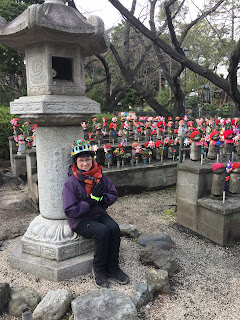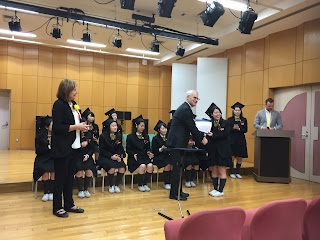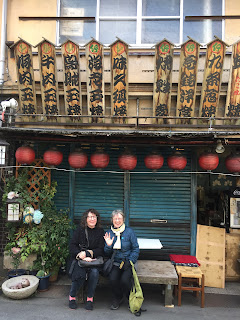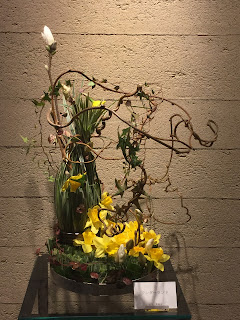As we are slowly inching towards spring for our third year here in Tokyo several events mark this time of year.
The arrival of the spring cherry blossoms is a hotly anticipated event here with web-sites to track the exact time and people planning their "Hanami" parties already. We have enjoyed being out on long city walks between the bouts of rain to discover and appreciate the arrival of the plum blossoms.
D
Shelley has decorated her helmet for the occasion to totally blend in with the background... flower "camo" as it were.
The parks are full of people out enjoying the blossoms, striking the "kawai" (cute) poses with close-ups of blossoms.
Of course this is also the opportunity to bring the prized dogs out for a walk in their spring finery; note that those are not baby strollers but dog strollers just in case "Little Fluffy" gets tired from excessive walking.
Some of the Jizos at the temple to honour aborted and deceased babies have their winter jackets and hats on.
though the days are warming up.
At school this is also grad season for our grade 12 students and exam season for our grade 11 and 10 students.
This is my third end of year season, but the first time that we have had graduates from the BSCIS school; VERY exciting!
As Shelley and I have decided to return home to BC at the end of this school year, March 30th, this is also a time for reflection and mixed emotions as we wrap up this stage of our lives.
After three years of hard work, the students start their grad events with a special class called "Manners class" taught and prepared by the staff at the Regency Hyatt Tokyo (wow!). We were all seated around tables set beautifully in the "Western" style, prepared for a 2 hour lecture on all the subtleties of manners at a sumptuous banquet in the West.

Just in case we had any questions, each setting had a "Manners" book so you could read up on the finer points of manners.
Our grade 12 students waiting for the banquet to begin.
Our Japanese principal and myself... also waiting for instructions.
This video gives a feel for the event; check out the student behaviour as the camera scans...
We learned about the origins of the fork, the direction to move your spoon, which knife is used when, all of the important things necessary to function in the West. 😊😊 And then, of course, we enjoyed a fabulous 4 course lunch!
Returning to the school site I pause to remember how specially I am treated here in so many ways. When I enter the front entrance and change my shoes... I have the "corner office" of the shoe boxes; the top left corner closest to the school; high prestige!
Graduation is an exciting time especially for the homeroom teacher who has been with the class since grade 10. Atsushi was the first homeroom teacher in BSCIS... a brave pioneer.
The main gym is always an impressive site as it is set to sit the 1000 plus high-school students and their parents.
The main Japanese ceremony is a very formal, quiet and thoughtful event with beautiful songs sung by the grade 11 as a good-bye to the grade 12 and vice versa. There are also many speeches by the various dignitaries and students receiving awards. Students and audience are very quiet during the whole ceremony. I had the opportunity to hand out the first BSCIS diplomas at the main Japanese grad.
From the very formal Japanese graduation ceremony with the help of the DD teachers and the students we organized a full-on BC style graduation. First and most importantly, the students were thrilled to receive an actual graduation hat with a tassle (a must for a BC grad! 😊). They marched to their seats with "Pomp and Circumstance" playing and with the audience standing, cheering and hooting.
We appreciated the remarks from the Japanese Principal as well as remarks from our Offshore School Representative. I also had an opportunity to talk to the students and parents about how brave they have been starting out this school.
Students gave thanks to the parents and to the teachers...
while teachers thanked the students. All of the speeches had a nice blend of humour and emotion.
As the certificates were handed out and students flipped their tassels carefully, people enjoyed the laughter, appreciation and clapping (mixed in with a few hoots) as they tossed their caps into the air.
The event finished with an emotional slide show reviewing 3 years of study, hard work, humour, expeditions and fun times. There were lots of tears and laughter as the slides were called up.
It was very meaningful to me to have a whole variety of parents come up to express their appreciation for the work I had done over these years.
These students have been accepted to amazing universities all over the world. 70% of them were accepted to the top tier Japanese universities here in Tokyo. 30% have been accepted or are close to being accepted to universities around the world: Maastricht, Prague, Vancouver, Whitehorse.
These excellent results have really caught the attention of the public in Tokyo. We received a beautiful bouquet from the British Columbia Office here in Tokyo.
From an original field of 17 applicants (we accepted 15) this year we had 84 (!!) applicants and accepted 45 bright, thoughtful, passionate boys and girls for next year. On an almost daily basis we hear from parents wanting to find out how to enroll their child for the coming year.
I leave this school feeling excited about its' possibilities. The blend of two cultures, of students learning the best of each world (Japanese and BC education) have created a powerful opportunity for the vibrant students to pursue their dreams both in Japan and around the world.
It has been a professional thrill for me to facilitate and encourage the student-centered approach linked to "active learning" that we do in BC through field trips, debates, presentations and other approaches to creative thinking.
With their strong study skills, their intense drive and their curiosity these wonderful Japanese students have really taken the opportunities provided by the BC curriculum and taken off to pursue their dreams.
I am truly grateful for this opportunity to work and live in Tokyo, to start this new BC Offshore school and to see it blossom into maturity. I am grateful for the kind administrative team, my Japanese colleagues, who have worked so closely with me over these three years as we created this school and set precedents for the coming years. I feel honoured to have been the first principal here at BSCIS Tokyo and I wish the whole team success in the coming years.

As a parting image of my time here our English 11 teacher had students created visual depictions of what they needed to remember as they entered this season of intense exams and pressure. I leave these three years of intensity and pressure (and fun and celebration!) with this message for myself.
Stay posted for new adventures in the next phase of our lives.
























































